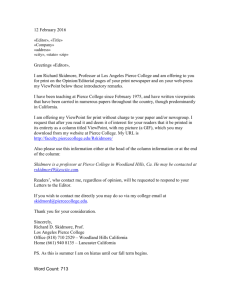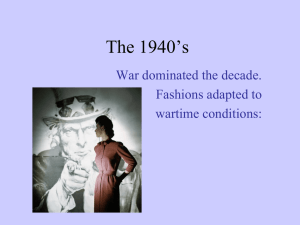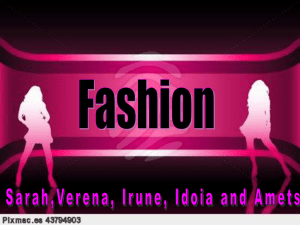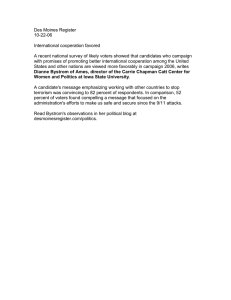Baltimore Sun, MD 01-04-07 Pelosi suited for politics
advertisement
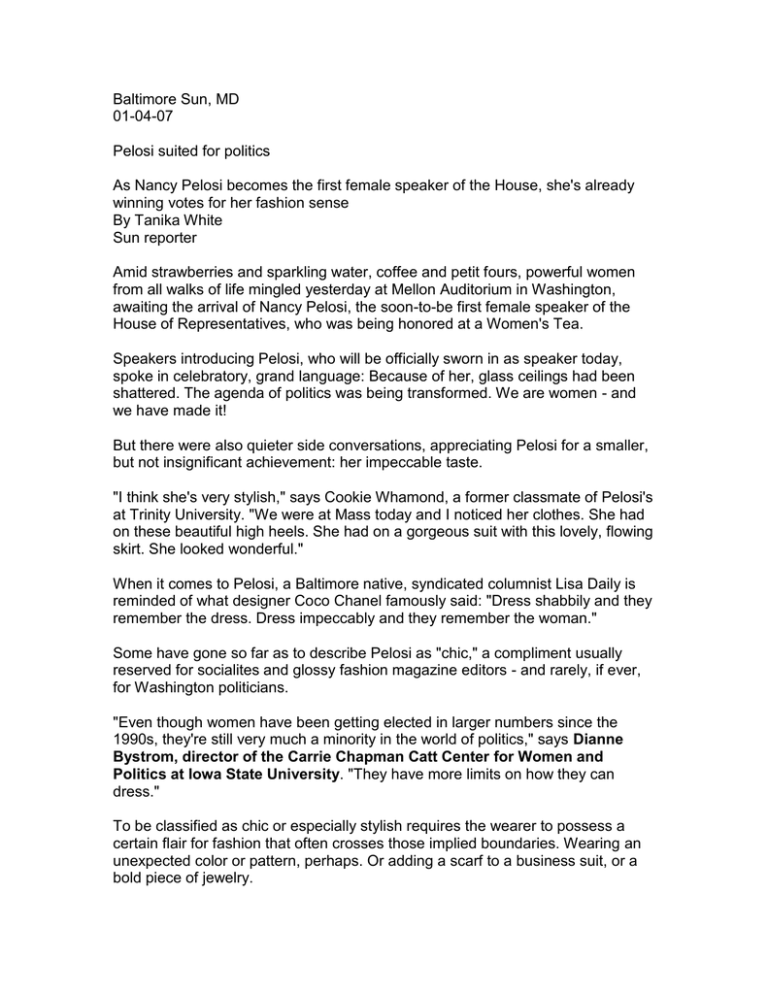
Baltimore Sun, MD 01-04-07 Pelosi suited for politics As Nancy Pelosi becomes the first female speaker of the House, she's already winning votes for her fashion sense By Tanika White Sun reporter Amid strawberries and sparkling water, coffee and petit fours, powerful women from all walks of life mingled yesterday at Mellon Auditorium in Washington, awaiting the arrival of Nancy Pelosi, the soon-to-be first female speaker of the House of Representatives, who was being honored at a Women's Tea. Speakers introducing Pelosi, who will be officially sworn in as speaker today, spoke in celebratory, grand language: Because of her, glass ceilings had been shattered. The agenda of politics was being transformed. We are women - and we have made it! But there were also quieter side conversations, appreciating Pelosi for a smaller, but not insignificant achievement: her impeccable taste. "I think she's very stylish," says Cookie Whamond, a former classmate of Pelosi's at Trinity University. "We were at Mass today and I noticed her clothes. She had on these beautiful high heels. She had on a gorgeous suit with this lovely, flowing skirt. She looked wonderful." When it comes to Pelosi, a Baltimore native, syndicated columnist Lisa Daily is reminded of what designer Coco Chanel famously said: "Dress shabbily and they remember the dress. Dress impeccably and they remember the woman." Some have gone so far as to describe Pelosi as "chic," a compliment usually reserved for socialites and glossy fashion magazine editors - and rarely, if ever, for Washington politicians. "Even though women have been getting elected in larger numbers since the 1990s, they're still very much a minority in the world of politics," says Dianne Bystrom, director of the Carrie Chapman Catt Center for Women and Politics at Iowa State University. "They have more limits on how they can dress." To be classified as chic or especially stylish requires the wearer to possess a certain flair for fashion that often crosses those implied boundaries. Wearing an unexpected color or pattern, perhaps. Or adding a scarf to a business suit, or a bold piece of jewelry. Pelosi has, at some point, done all these things, and then some, with success. During a televised interview with NBC's Tim Russert last summer, Pelosi's jacket was an unconventional pale green. She paired a gray suit with an of-the-moment, multistrand of black pearls on election night. And once, at a forum to discuss health care during the Democratic National Convention, Pelosi's bold yellow pantsuit was accentuated with a scarf, neatly wrapped and tucked at her neckline. The effect isn't fabulous, so much as it is solidly feminine - a trait many of her female counterparts hesitate to project, or worse, are unable to do without appearing frilly and out-of-place. Most play it safe Too often, says Kirsten Osolind, CEO of Re:Invention Inc., a marketing agency that helps corporations sell more of their products and services to working women, female politicians are excoriated for fashion choices that are too feminine or fierce. That may be why, to be safe, many female politicians stay within the established fashion parameters set by their male peers: black, navy blue, gray. Stiff, boxy, angular. And few accoutrements. But Pelosi confidently bucks that trend. She uses color in a manner few of her peers seem comfortable doing. Red is a Pelosi favorite, showing up quite often since her Democratic caucus election to be speaker - most notably, in the form of a collarless suit, with a single button closure at the neckline, which she wore to a news conference last month. But she also has been seen in such decidedly non-Washingtonian colors as sea foam and pale pink. She's been photographed leaving meetings in a stunning suit of all-white. Her use of jewelry and accessories often gets noticed. At the Women's Tea yesterday, Pelosi wore her signature multi-colored, South Sea Tahitian pearls, with a gray suit and black shirt, adding instant life to the traditional outfit. Those pearls, according to a Los Angeles Times article, garnered so much attention after Pelosi first appeared in them on television, dozens of women called a pearl wholesaler demanding necklaces just like it for themselves. Indeed, she seems to have already started a bit of a fashion trend: Many of the invitees at the tea - young and old - wore similar strands of large baubles. "I love her look and her hair," says image consultant Sandy Dumont, who calls herself The Image Architect, "and I use her as a good example for all my female executives. She has the epitome of the understated, 'old money' look. Old money doesn't shout ... old money is discreet and classy, never flashy." Republicans have attempted to brand Pelosi as "too liberal," but her fashionsense - except, perhaps, for her comfort with color - is anything but. She is conservative in the way a woman in her position should be, experts say, well puttogether, but not boring. "Speaker Pelosi tends to wear suits with clean lines and quality fabrics, an indication of her no-nonsense, to-the-point leadership style," says Marva Goldsmith, president and chief image officer of Marva Goldsmith and Associates, a Washington-area image consultant, branding and marketing firm. "No fuss, no bows, no doo-dads, thank goodness!" Even as a young woman, growing up in Baltimore's Little Italy, Pelosi always had an ease with clothes and a penchant for quality, says her brother Thomas J. D'Alesandro III, who served as mayor of Baltimore from 1967 to 1971. Their father, Thomas D'Alesandro Jr., was a congressman from 1939 to 1947 and mayor from 1947 to 1959. 'Style' and 'grace' "She always conducted herself with style, with grace," says D'Alesandro, noting that his sister never went through an awkward, ugly duckling phase, struggling with various hairstyles or unfortunate trends. "She wasn't a tomboy." Pelosi's upbringing in the Italian, Catholic neighborhood - as the youngest child and only daughter in a political family - was a modest one, D'Alesandro says. But Pelosi still managed to appear at all times "very debonair." "There wasn't a lot of money for the best kind of clothes," D'Alesandro says. "But whatever the family could afford, Nancy got the best of. Wherever she went from school to recreation - she was always well-groomed with clean clothes." Today, Pelosi can afford "the best kind of clothes," and her tendency toward designer lines, such as Armani, has been met with both praise and criticism. "I read that she wears Armani," says Cheryl Cooper, executive director of the National Council of Negro Women, who went to the Women's Tea yesterday, in a blue Escada suit. "And I'm an Armani fan. Armani is tailored but still allows a woman to maintain her femininity at the same time. I don't think we have to look like men to be effective in our jobs." Detractors have said Pelosi's love of Armani suggests a disassociation with those in "the real world," most of whom probably could not afford the high-end line. But some female business leaders say a woman in Pelosi's position is smart to dress herself in the label. "If you are a woman going into the battlefield of politics and power, knowing that you risk being flattened at any moment, you should armor up with clothes that convey style, confidence, competence and project the image of a woman who can carry herself with power, grace and dignity," says Debra Condren, founder of the Women's Business Alliance. "And, hey, if you're going to get knocked to your knees, you should be wearing that great Armani suit. Wearing powerful clothes, you'll look more in control as you regain your footing." Still, some wonder if there isn't too much attention altogether on what Pelosi wears. After all, was there ever this much discussion about her predecessor Rep. Dennis Hastert's fashion sense? Or Newt Gingrich's? Gender stereotypes have long dogged women in politics, says Bystrom of Iowa State. While male candidates were covered in terms of their platforms, women too often were asked about the three H's: husbands, hairdos and hemlines. Men vs. women "Men got to say 'this is what I stand for. This is what I believe in,'" Bystrom says. "Women, instead, were covered in terms of, 'This is what I'm wearing and this is what my hair looks like and these are my kids and this is what my husband does.'" Public interest about style for female leaders may be unavoidable, though. No less a political player than Hillary Rodham Clinton, whose hairstyles have been dissected endlessly since before she became first lady in 1992, told National Public Radio last month, "They [the voters] get to take a measure of you. They get to decide whether they like your position on energy or whether they like your hairstyle. It's all fair game." Osolind, of Re:Invention, says female politicians "have good reason to long for the day that they can silence the conversation about their clothes." "We should be focusing our attention on Pelosi's diplomacy and new Congress agenda," she says. But even Osolind can't help but add, "then again, the Manolo Blahniks Pelosi wore [recently] were pretty darn nifty."
